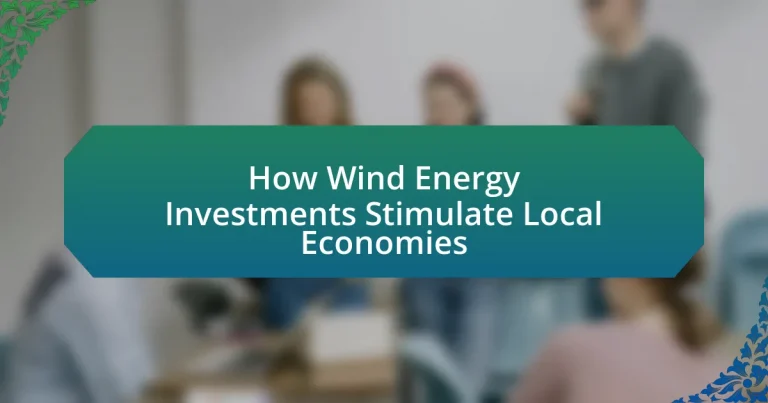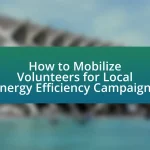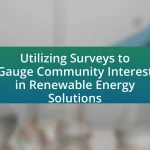Wind energy investments play a significant role in stimulating local economies by creating jobs, increasing tax revenues, and supporting local businesses. The article outlines the primary economic benefits of wind energy, including job creation, enhanced local tax revenues, and reduced energy costs, highlighting that the wind sector employed over 116,000 workers in the U.S. in 2020. It also discusses how wind projects influence local businesses and community engagement, while addressing challenges such as land use and environmental concerns. Furthermore, the article emphasizes strategies for maximizing the benefits of wind energy investments, including community ownership and stakeholder engagement, as well as metrics for evaluating their success.
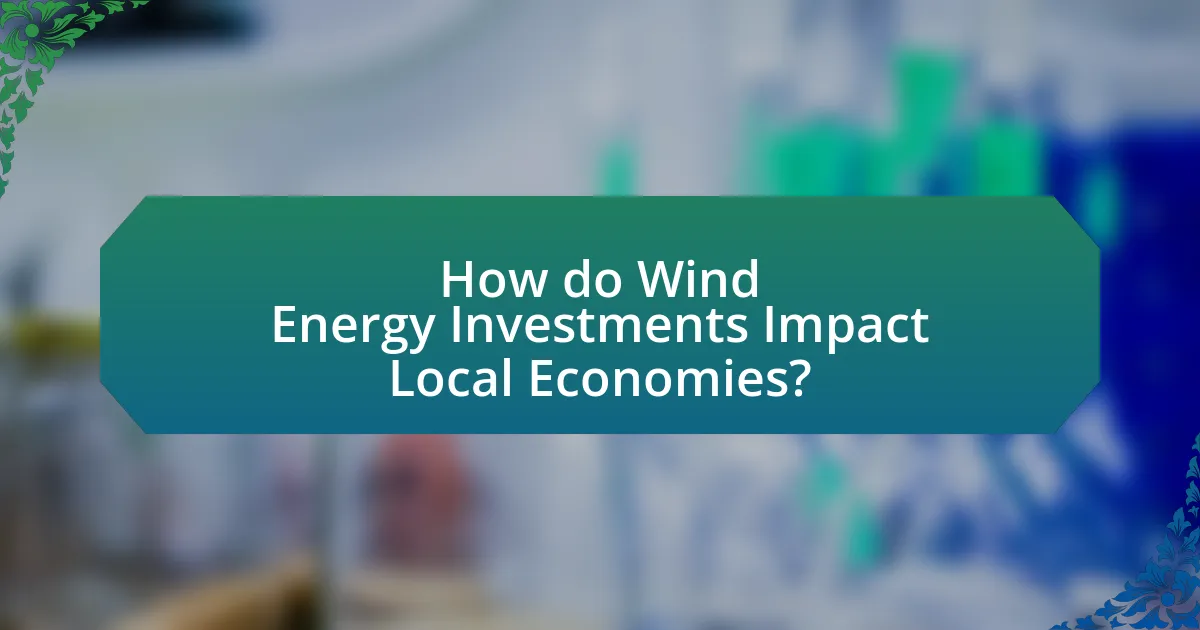
How do Wind Energy Investments Impact Local Economies?
Wind energy investments positively impact local economies by creating jobs, increasing tax revenues, and stimulating local businesses. For instance, the American Wind Energy Association reported that the wind industry supported over 100,000 jobs in the U.S. in 2020, with many of these positions being local, such as in manufacturing, installation, and maintenance of wind turbines. Additionally, wind projects contribute to local tax bases, providing funding for schools, roads, and emergency services; in 2019, wind energy projects contributed approximately $1.9 billion in state and local tax payments. Furthermore, local businesses benefit from increased demand for services and supplies related to wind energy projects, which can lead to economic diversification and resilience in rural areas.
What are the primary economic benefits of wind energy investments?
The primary economic benefits of wind energy investments include job creation, increased local tax revenues, and reduced energy costs. Job creation occurs as wind projects require skilled labor for construction, operation, and maintenance; for instance, the U.S. wind sector employed over 116,000 workers in 2020, according to the U.S. Department of Energy. Increased local tax revenues arise from property taxes and lease payments to landowners, which can enhance funding for schools and infrastructure. Additionally, wind energy investments lead to reduced energy costs for consumers, as the levelized cost of wind energy has decreased by 70% since 2009, making it one of the most cost-effective energy sources available.
How do job creation and employment rates change with wind energy projects?
Job creation and employment rates increase significantly with wind energy projects. Research indicates that for every megawatt of wind capacity installed, approximately 1.17 jobs are created during the construction phase and 0.4 jobs are sustained during operation and maintenance. For instance, the U.S. Department of Energy reported that the wind sector employed over 116,000 workers in 2019, reflecting a growth of 61% since 2013. This trend demonstrates that investments in wind energy not only create direct employment opportunities but also stimulate local economies through ancillary job creation in related sectors.
What is the effect of wind energy investments on local tax revenues?
Wind energy investments generally increase local tax revenues. This occurs because wind farms contribute to property taxes, which are often levied on the value of the infrastructure. For instance, a study by the American Wind Energy Association found that wind projects can generate millions in tax revenue for local governments, which can be used for public services such as education and infrastructure. Additionally, these investments can lead to job creation and increased economic activity, further enhancing the tax base.
How do wind energy projects influence local businesses?
Wind energy projects positively influence local businesses by creating job opportunities and increasing local spending. The construction and maintenance of wind farms require a variety of services, from construction to logistics, which can lead to the hiring of local workers and the engagement of local suppliers. For instance, a study by the National Renewable Energy Laboratory found that for every megawatt of wind energy installed, approximately 1.17 jobs are created in the local economy. Additionally, increased local spending occurs as workers and contractors purchase goods and services from nearby businesses, further stimulating economic growth in the area.
What types of local businesses benefit from wind energy investments?
Local businesses that benefit from wind energy investments include construction firms, manufacturing companies, and service providers. Construction firms gain from the demand for building wind turbines and related infrastructure, while manufacturing companies produce components such as blades and gearboxes. Service providers, including maintenance and repair businesses, also see increased opportunities as wind farms require ongoing support. According to the U.S. Department of Energy, the wind sector supported over 100,000 jobs in 2020, demonstrating the significant economic impact on local businesses involved in these areas.
How do wind energy projects stimulate demand for local services?
Wind energy projects stimulate demand for local services by creating job opportunities and increasing the need for various support services. The construction and maintenance of wind farms require local contractors, suppliers, and service providers, which leads to a boost in local employment. For instance, a study by the National Renewable Energy Laboratory found that for every megawatt of wind energy installed, approximately 1.5 jobs are created in the local economy. Additionally, these projects often necessitate services such as transportation, catering, and equipment maintenance, further driving demand for local businesses. This interconnectedness enhances the overall economic activity within the community, demonstrating the positive impact of wind energy investments on local economies.
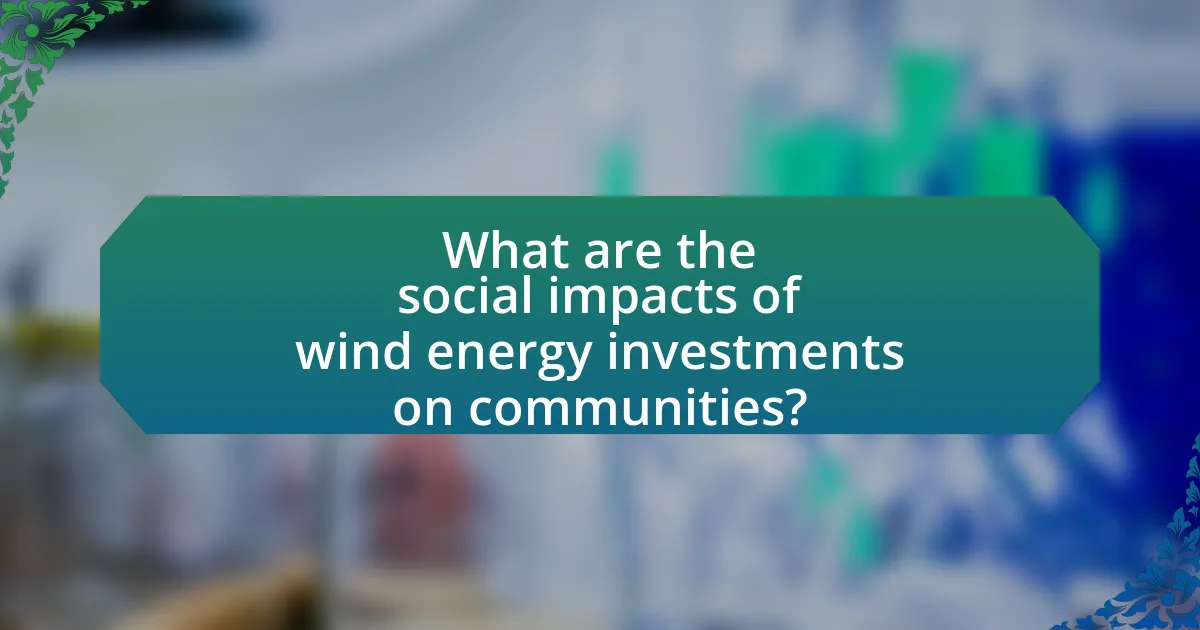
What are the social impacts of wind energy investments on communities?
Wind energy investments positively impact communities by creating jobs, enhancing local economies, and fostering social cohesion. These investments lead to the establishment of new employment opportunities in construction, maintenance, and operation of wind farms, which can significantly reduce local unemployment rates. For instance, a study by the U.S. Department of Energy found that wind energy projects can create approximately 1.17 jobs per megawatt of installed capacity during construction and 0.4 jobs per megawatt during operation. Additionally, wind energy projects often contribute to local tax revenues, which can be reinvested in community services such as education and infrastructure, further enhancing the quality of life for residents. Furthermore, the presence of wind farms can promote community engagement and collaboration among residents, as they often participate in discussions about project development and benefits.
How do wind energy projects affect community engagement and participation?
Wind energy projects significantly enhance community engagement and participation by fostering local involvement in decision-making processes and creating economic opportunities. These projects often include community consultations and informational meetings, which encourage residents to voice their opinions and concerns, thereby increasing transparency and trust. For instance, a study by the National Renewable Energy Laboratory found that communities involved in wind energy projects reported higher levels of satisfaction and engagement compared to those not involved. Additionally, local job creation and investment in community infrastructure associated with wind energy projects further motivate residents to participate actively, as they see direct benefits to their local economy.
What role do local stakeholders play in wind energy project development?
Local stakeholders play a crucial role in wind energy project development by influencing decision-making, ensuring community support, and facilitating the integration of projects into local economies. Their involvement often includes providing insights on local environmental concerns, land use, and community needs, which can shape project design and implementation. For instance, studies have shown that projects with strong local stakeholder engagement tend to experience fewer conflicts and greater acceptance, leading to smoother development processes and enhanced economic benefits for the community. Additionally, local stakeholders can help secure necessary permits and foster partnerships that enhance project viability, ultimately contributing to job creation and local investment.
How can community benefits agreements enhance local support for wind energy?
Community benefits agreements (CBAs) enhance local support for wind energy by ensuring that local communities receive tangible benefits from wind projects, such as job creation, financial contributions, and infrastructure improvements. These agreements foster trust and collaboration between developers and residents, addressing concerns about environmental impacts and economic disparities. For instance, a study by the National Renewable Energy Laboratory found that projects with CBAs often experience higher levels of community acceptance and participation, as they align the interests of developers with those of local stakeholders, ultimately leading to smoother project implementation and increased local investment.
What challenges do communities face with wind energy investments?
Communities face several challenges with wind energy investments, including concerns about land use, noise pollution, and potential impacts on local wildlife. Land use conflicts arise when wind farms are proposed on agricultural or residential areas, leading to opposition from residents and farmers. Noise pollution from turbine operation can affect nearby communities, causing discomfort and health concerns. Additionally, wind energy projects may disrupt local ecosystems, particularly bird and bat populations, which can lead to environmental backlash. These challenges can hinder the successful implementation of wind energy projects and affect community support, as evidenced by various case studies where local opposition has stalled or canceled proposed developments.
How do concerns about land use and environmental impact arise?
Concerns about land use and environmental impact arise primarily from the potential disruption of ecosystems and local communities due to development projects. For instance, the installation of wind energy farms can lead to habitat loss for wildlife, changes in land use patterns, and visual impacts on the landscape. Studies have shown that large-scale wind energy projects can affect local flora and fauna, prompting community opposition and regulatory scrutiny. Additionally, the need for land to accommodate turbines and associated infrastructure raises questions about competing land uses, such as agriculture or conservation, further intensifying these concerns.
What strategies can mitigate opposition to wind energy projects?
Engaging local communities through transparent communication and education can mitigate opposition to wind energy projects. By providing clear information about the benefits, such as job creation and economic stimulation, stakeholders can address misconceptions and fears. Research indicates that projects with community involvement and local investment tend to face less resistance; for instance, a study by the National Renewable Energy Laboratory found that community-owned wind projects have higher acceptance rates. Additionally, offering financial incentives or revenue-sharing models can further align the interests of local residents with the project, fostering a sense of ownership and support.
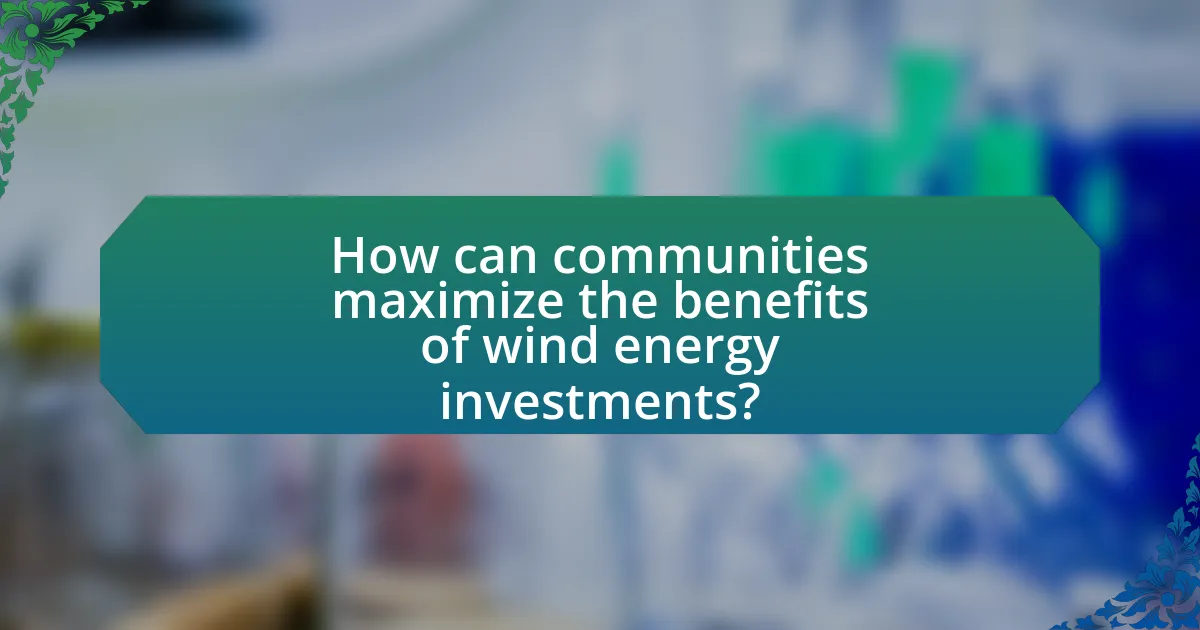
How can communities maximize the benefits of wind energy investments?
Communities can maximize the benefits of wind energy investments by actively engaging in local planning, ensuring community ownership, and fostering partnerships with developers. Engaging in local planning allows communities to tailor wind projects to their specific needs, enhancing local acceptance and participation. Community ownership models, such as cooperatives, enable residents to share in the financial benefits, which can lead to increased local investment and job creation. Furthermore, partnerships with developers can facilitate knowledge transfer and ensure that a portion of the economic benefits, such as tax revenues and job opportunities, remain within the community. For instance, a study by the National Renewable Energy Laboratory found that local ownership of wind projects can lead to a 50% increase in local economic benefits compared to traditional models.
What best practices should communities adopt for successful wind energy projects?
Communities should adopt stakeholder engagement, thorough site assessments, and transparent communication as best practices for successful wind energy projects. Engaging local stakeholders ensures that community concerns and interests are addressed, fostering support and collaboration. Conducting comprehensive site assessments, including environmental impact studies, helps identify suitable locations and mitigate potential issues, which is crucial for project viability. Transparent communication throughout the project lifecycle builds trust and keeps the community informed, which is essential for long-term success. These practices are supported by studies indicating that community involvement and clear communication significantly enhance project acceptance and operational efficiency.
How can local governments facilitate wind energy development?
Local governments can facilitate wind energy development by implementing supportive policies and providing financial incentives. These policies may include streamlined permitting processes, zoning regulations that favor wind projects, and tax breaks or grants for developers. For instance, states like Texas have successfully attracted wind energy investments by offering property tax incentives, resulting in over 30,000 megawatts of installed wind capacity as of 2021. Additionally, local governments can engage in community outreach to educate residents about the benefits of wind energy, fostering public support and reducing opposition. This combination of policy support and community engagement has proven effective in promoting wind energy projects and stimulating local economies.
What role does education and awareness play in community acceptance of wind energy?
Education and awareness significantly enhance community acceptance of wind energy by informing residents about its benefits and addressing misconceptions. When communities are educated about the environmental advantages, economic opportunities, and technological advancements associated with wind energy, they are more likely to support local projects. For instance, studies have shown that informed communities exhibit a 20% higher acceptance rate of wind energy initiatives compared to those lacking awareness. This correlation underscores the importance of targeted educational programs and outreach efforts in fostering a positive perception of wind energy, ultimately leading to increased investment and development in local economies.
What are the long-term economic strategies related to wind energy investments?
Long-term economic strategies related to wind energy investments include diversifying energy portfolios, enhancing local job creation, and fostering technological innovation. Diversifying energy portfolios allows regions to reduce dependence on fossil fuels, thereby stabilizing energy prices and promoting sustainability. For instance, the U.S. Department of Energy reported that wind energy jobs grew by 61% from 2013 to 2019, indicating significant local employment opportunities. Additionally, investments in wind technology drive innovation, leading to cost reductions; the National Renewable Energy Laboratory found that the cost of wind energy has decreased by 70% since 2009. These strategies collectively contribute to economic resilience and growth in local economies.
How can communities ensure sustainable economic growth from wind energy?
Communities can ensure sustainable economic growth from wind energy by investing in local wind projects and creating supportive policies that encourage renewable energy development. By establishing community-owned wind farms, local stakeholders can retain a larger share of the economic benefits, such as job creation and revenue generation. For instance, a study by the National Renewable Energy Laboratory found that local ownership of wind projects can lead to increased local investment and job opportunities, with wind energy supporting over 100,000 jobs in the U.S. alone as of 2020. Additionally, implementing policies that provide tax incentives and streamline permitting processes can further attract investment and foster a favorable environment for wind energy development, ultimately contributing to long-term economic sustainability.
What metrics should be used to evaluate the success of wind energy investments?
The metrics used to evaluate the success of wind energy investments include return on investment (ROI), capacity factor, levelized cost of energy (LCOE), and job creation. ROI measures the profitability of the investment, indicating how much profit is generated relative to the cost. Capacity factor assesses the efficiency of wind turbines by comparing actual energy output to potential output under optimal conditions, with successful projects typically achieving factors above 30%. LCOE calculates the average cost per unit of electricity generated over the project’s lifetime, with competitive LCOE values often below $50 per megawatt-hour for onshore wind. Job creation metrics evaluate the number of jobs generated during construction and operation phases, with studies showing that each megawatt of installed wind capacity can create approximately 1.5 jobs. These metrics collectively provide a comprehensive assessment of the economic viability and impact of wind energy investments.
